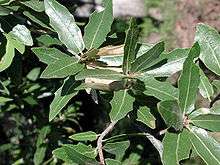Quercus emoryi
| Emory oak | |
|---|---|
 | |
| Scientific classification | |
| Kingdom: | Plantae |
| (unranked): | Angiosperms |
| (unranked): | Eudicots |
| (unranked): | Rosids |
| Order: | Fagales |
| Family: | Fagaceae |
| Genus: | Quercus |
| Section: | Lobatae |
| Species: | Q. emoryi |
| Binomial name | |
| Quercus emoryi Torr. (1848) not Porter & J.M.Coult. 1874 | |
 | |
| Natural range of Quercus emoryi | |
| Synonyms[1] | |
| |
Quercus emoryi, the Emory oak, is a species of oak common in Arizona (including inside Saguaro National Park), New Mexico and western Texas (including inside Big Bend National Park), United States, and northern Mexico (Sonora, Chihuahua, Coahuila (including Parque Nacional Maderas del Carmen), Durango, Nuevo León, and San Luis Potosí).[2][3] It typically grows in dry hills at moderate altitudes.
Quercus emoryi is an evergreen tree in the red oak group, retaining its leaves through the winter until the new leaves are produced in spring, and is a large shrub or small tree from 5–17 meters (16–56 ft) tall. The leaves are 3–6 cm (1–2.5 in) long, entire or wavy-toothed, leathery, dark green above, paler below. The acorns are 1.5–2 cm (0.59–0.79 in) long, blackish-brown, and mature in 6–8 months from pollination; the kernel is sweet, and is an important food for many mammals and birds.[4]
The tree is named after the United States Army surveyor, Lieutenant William Hemsley Emory, who surveyed the area of west Texas where it was discovered in 1846.
References
External links
| Wikimedia Commons has media related to Quercus emoryi. |